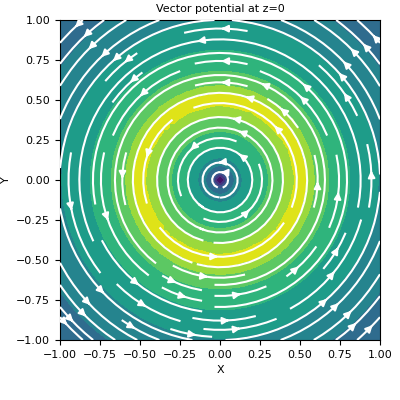geoana.em.static.CircularLoopWholeSpace.vector_potential#
- CircularLoopWholeSpace.vector_potential(xyz, coordinates='cartesian')#
Compute the vector potential for the static loop in a wholespace.
This method computes the vector potential for the cirular current loop at the set of gridded xyz locations provided. Where \(\mu\) is the magnetic permeability, \(I d\mathbf{s}\) represents an infinitessimal segment of current at location \(\mathbf{r_s}\) and \(\mathbf{r}\) is the location at which we want to evaluate the vector potential \(\mathbf{a}\):
\[\mathbf{a}(\mathbf{r}) = \frac{\mu I}{4\pi} \oint \frac{1}{|\mathbf{r} - \mathbf{r_s}|} d\mathbf{s}\]The above expression can be solve analytically by using the appropriate change of coordinate transforms and the solution for a horizontal current loop. For a horizontal current loop centered at (0,0,0), the solution in radial coordinates is given by:
\[a_\theta (\rho, z) = \frac{\mu_0 I}{\pi k} \sqrt{ \frac{R}{\rho^2}} \bigg [ (1 - k^2/2) \, K(k^2) - E(k^2) \bigg ]\]where
\[k^2 = \frac{4 R \rho}{(R + \rho)^2 + z^2}\]and
\(\rho = \sqrt{x^2 + y^2}\) is the horizontal distance to the test point
\(I\) is the current through the loop
\(R\) is the radius of the loop
\(E(k^2)\) and \(K(k^2)\) are the complete elliptic integrals
- Parameters:
- xyz(…, 3) numpy.ndarray xyz
gridded locations at which we calculate the vector potential
- coordinates: str {‘cartesian’, ‘cylindrical’}
coordinate system that the location (xyz) are provided. The solution is also returned in this coordinate system. Default: “cartesian”
- Returns:
- (…, 3) numpy.ndarray
The magnetic vector potential at each observation location in the coordinate system specified in units Tm.
Examples
Here, we define a horizontal loop and plot the vector potential on the xy-plane that intercepts at z=0.
>>> from geoana.em.static import CircularLoopWholeSpace >>> from geoana.utils import ndgrid >>> from geoana.plotting_utils import plot2Ddata >>> import numpy as np >>> import matplotlib.pyplot as plt
Let us begin by defining the loop.
>>> location = np.r_[0., 0., 0.] >>> orientation = np.r_[0., 0., 1.] >>> radius = 0.5 >>> simulation = CircularLoopWholeSpace( >>> location=location, orientation=orientation, radius=radius >>> )
Now we create a set of gridded locations and compute the vector potential.
>>> xyz = ndgrid(np.linspace(-1, 1, 50), np.linspace(-1, 1, 50), np.array([0])) >>> a = simulation.vector_potential(xyz)
Finally, we plot the vector potential on the plane. Given the symmetry, there are only horizontal components.
>>> fig = plt.figure(figsize=(4, 4)) >>> ax = fig.add_axes([0.15, 0.15, 0.8, 0.8]) >>> plot2Ddata(xyz[:, 0:2], a[:, 0:2], ax=ax, vec=True, scale='log') >>> ax.set_xlabel('X') >>> ax.set_ylabel('Y') >>> ax.set_title('Vector potential at z=0')
(
Source code,png,pdf)